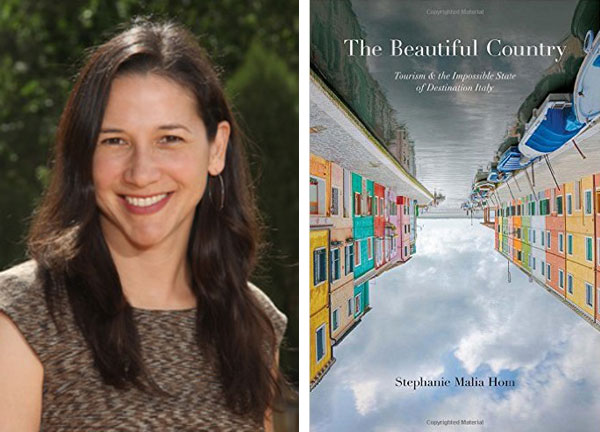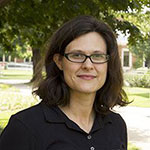Nostalgia for a Nonexistent Italy: An Interview with Stephanie Malia Hom

The University of Toronto Press released Stephanie Malia Hom’s The Beautiful Country: Tourism and the Impossible State of Destination Italy in February 2015. This book investigates the nonreversible effects foreign tourism has had on Italy as the place that is always visited. WLT and Stephanie Malia Hom consider why an increased awareness of tourism itself remains vital to Italy as both country and destination.
Andrea Bryant: I noticed something really interesting about the cover of your book. In the beginning, the picture is upside down, and then on the other side, it is right side up, as if they are mirror images of each other. Is there some symbolic significance to this?
Stephanie Malia Hom: There is, actually. I worked very closely with the graphic designer on the cover. We wanted to choose an image that was quite iconic so you could look at that image and say, “Oh, that is definitely Italy.” You can see that it’s Venice, and it is iconic. But what I’m doing in the book is turning everything we know about Italy on its head. What the reversal of that image intended to do is to say that even though it is an iconic thing, there’s a different way to look at it. There is a different angle that we need to consider and that angle is the imaginary of what I call Destination Italy. It’s a touristic imagination of Italy that is very clear to many people. It’s one of the top tourist destinations in the world.
As I was writing this book, it really struck me that there was no in-depth consideration of Italy as a tourist destination. There were histories of tourism in Italy, but there was not one book that considers not just the histories of tourism but the rhetorical productions surrounding them as well as the ways in which this Destination Italy spills over national borders and begins to travel the world itself.
There is the Italy of Italians that ooze glamour, and they are living this dolce vita. It’s all about style, excess and hedonism in some way and the sweet life, la dolce vita: the sweet life of idleness in the beautiful country. This is really a way that Italy, particularly after World War II, has rebranded itself. I think it really gained momentum in the 1980s with the Made in Italy campaign. This was an advertising campaign that linked Italian consumer goods, in particular, to notions of small-scale family production, from artisanal craftsmanship to high-quality luxury goods. This was a far cry from post–WWII Italy, which was considered very poor and “backward.”
Up until that time in the United States, Italians were stereotyped as “dirty” and “inferior” immigrants; scholars of Italian American history have shown they weren’t even considered white in many contexts and so suffered from much discrimination. Italy was the country that was the source of the largest voluntary immigration recorded in world history. Between 1870, I believe, and 1940, something close to twenty million Italians left to go/come to the Americas, the Antipodes, and elsewhere in Europe. In fact, there were more Italians in French Tunisia than French up until the 1930s.
My goal with the book was to show how the imaginary of Italy, which is rooted in the advent of mass tourism, has grown and shaped not only the nation-state of Italy but also all the external and internal ideas of what Italy and Italian culture might be.
AB: So would you say this flipping occurred mainly after World War II?
SMH: I think it was really in the 1950s that Italy went through something called the boom economico, the economic boom, similar to the US. Prior to that, Italy was poverty stricken—there was hunger and disease throughout the entire country. Especially in the South, where it became known as la miseria, the “misery” associated with living there.
There was the invention of new technologies, such as radio and TV, and particularly the automobile. There was Fiat, which was really the quintessential firm that led this economic boom in the late 1940s, ’50s, and ’60s. The Fiat 500 became the symbol of this new Italian economy, and this new Italian economy became linked with leisure, in particular with luxury goods and consumerism. This was a time when highways were being built to the beach, holiday villages were being built, and Italians were beginning to tour their own country en masse but also in their individual cars as well. This created a shift from the kind of organized tourism that happened in the late nineteenth and early twentieth century and under the Fascist regime to the much more individualized, middle-class Italians, who started to tour their own country in the ’50s and ’60s.
One of the things that is really unique to Italian domestic tourism is the constitutive influence of foreign tourism to begin with. Italy was the land of the Grand Tour, which begins in the eighteenth century and ends the moment Napoleon marches through Europe.
One of the things that is really unique to Italian domestic tourism is the constitutive influence of foreign tourism to begin with. Italy was the land of the Grand Tour, which begins in the eighteenth century and ends the moment Napoleon marches through Europe. Before that it was the land of Christian pilgrimage and the Roman Empire. It was a place that had always been visited.
The Grand Tour sets up Italy as a site of aesthetics and leisure. Byron is going there to learn to see among the ruins. Italy becomes this place for nostalgia; it becomes this place for ruin gazing; it becomes this place for imagining the Golden Age of an idealized Classical past and, I should say, Renaissance past, too. Aristocrats from Britain and Europe went to Italy. Goethe, among them, famously, wrote his voyage to Italy. They began to set up this idealized Italy of what to see, where to go, and what to do. The stops on the Grand Tour are very much the same stops that any tourist would take today—Rome, Florence, and Venice. From the Grand Tour we jump to the middle of the nineteenth century.as the birth of modern mass tourism. This really began primarily in Britain but it also spread to France. In Victorian Britain, in particular, there was the creation of the seaside resort and the idea of “taking the waters” for health and going south for the winter, again, for the climate and for one’s health. Places like Nice and Cannes in France became resorts, and in England it was the resort of Blackpool. This is when we begin to see the seaside promenade emerge as a place where people go as tourists.
Before this, the sea and, in particular, the Mediterranean Sea was something to be feared. Up until the nineteenth century, the Mediterranean was for many in Italy, France, and Spain considered a “sea of fear” precisely because, in Italy at least, of the kidnappings and the barbarity. The coastlines were considered a very vulnerable space. In the 1500s, 1600s, and 1700s, there were a lot of kidnappings, in particular, of white Europeans being sold into slavery in North Africa. This is a little-known fact. A scholar by the name of Robert Davis has written a whole book about the enslavement of white Christians in Muslim North Africa, and at a certain point Algiers had a population of forty thousand Christian slaves, followed closely by Tunis and Tripoli (Libya). The sea in the Mediterranean was considered the space of fear where, if you were a white Christian living on the coastline, you could be vulnerable to pirates coming in and ransacking your village.
To consider the shift in the span of just fifty years from the Mediterranean being a sea of fear to a place where one goes to take the waters for health—this is a big shift. The development of these seaside resorts coincides with this shift, and coincides with the imaginary implemented by the Grand Tour whereby aristocrats traveling through Italy learned how to see art, learned about the Classical past, and learned about Renaissance masterpieces.
As the Industrial Revolution really took root in England, it was particularly Thomas Cook, whom I wrote about in the book, who began to think about ways to democratize travel, making the Grand Tour accessible to the masses, especially the middle class, who are now just beginning to have regularized working hours and are beginning to conceive of leisure as a right. So, in the mid-nineteenth century, Cook, who was originally a Baptist minister, begins to think that it is everybody’s right to travel and to have access to the Grand Tour, therefore he starts organizing these trips. In 1864 he takes his first group of tourists to Italy and inaugurates a profound change in the way that travel was done in Italy. Cook comes in and establishes entire routes and itineraries of how Italy should be toured and it is done so en masse. From 1864 to 1874, there were now tens of thousands of middle-class British tourists going to Italy.
This change was not lost on Italians. There was this sentiment of “Oh my goodness, tens of thousands of tourists are coming to our country and what are they seeing here?” In 1894 the Touring Club Italiano was founded, and this is the moment Italians took up the models that were instantiated by Cook, by Grand Tourists, by foreigners, and really created their own domestic tourism industry. That is different than, say, the tourism industry in France, which was much more generated from within. There were no foreign tourists going en masse in France the same way there were in Italy. They were going, but it didn’t have the same impact, which was also because France wasn’t really the primary site of the Grand Tour. It didn’t have that same gravitas of, for example, going to see the Roman Coliseum, the same way that it had for foreign tourists.
What was different about Italian tourism was precisely this beginning with foreign roots. Throughout the book I am tracing the way that it was externally generated, then internally generated, then externally, then internally. There is a dialectic, a mutual constitution, between these two so that we can’t imagine Italy without imagining it from both the outside and the inside. A lot of the scholarship on the Italian nation-state only considers the political imagining from within. What I’m saying is that, okay, yes, we have that body of literature, but at the same time, we also have to consider the external generations, the touristic imaginings of Italy.
AB: Would you say that you would agree with Thomas Cook’s democratization of travel?
SMH: I think that travel, of course, is very powerful and has the potential to really change somebody, just by coming in contact with different cultures. I think, as Americans, we should do more traveling to different countries and learn more languages, read more literature from other cultures, and read that literature in the original language to see what gets lost in translation.
But, for Cook, I do also think that there can be too much, or as they say in tourism studies, the “massification” of the industry. You think about the Costa del Sol in Spain, with its massive resorts, and I think that goes a little too far. The kind of tourism that I talk about in my book is what is classified as “heritage tourism.” Everything in Italy is heritage tourism. You aren’t really going there to lay on the beach. You aren’t there, as they say, for the four S’s—the sun, sea, sand, and sex. I agree with Cook’s general intention that travel is edifying, that we learn about other cultures and ourselves when we travel. I’m not sure that I agree that it should be done en masse to the extent that it is.
AB: But it seemed like in a lot of ways he did unify the infrastructure of Italy.
SMH: He really did; he played a critical role that has been overlooked. Not many people realize that Cook played such a big role and had this grand vision of what tourism in Italy would be, or should be, and he really put it into motion. To this day, we still travel those same routes, and Thomas Cook is still in business. The company is still running chartered tours to Italy.
AB: There seems to be a really interesting contrast between the religious and the sensual experiences of tourism to and within Italy.
SMH: There is a theory in tourism studies put forward by Nelson Graburn that tourism is essentially secular pilgrimage. We have our normal life, and then we go on tour and, just like when we go on pilgrimage, we cross into and over this liminal boundary in which we exist in another state. Some people call it the tourist bubble, and Victor Turner, a famous anthropologist, calls it communitas. We exist in this liminal state, which is what pilgrimage does, too, and then, after that, we come back to our normal lives. It would be a bell-shaped graph if you were going to graph it.
Pilgrimage in Italy is really interesting because, of course, it was the seat of the Christian Empire, and the Catholic Church in particular. We see the fusion of Classical and Christian ideals that begins, of course, in the Renaissance. What the Renaissance did was to look back to the Classical past and see what kind of ideals were set forth there and how those could be integrated with Christian ideals.
One of the guidebooks that I talk about, the Mirabilia Urbis Romae, is considered the first proto-guidebook. It was published in the twelfth century and was the first itinerary. It’s in the great tradition of Classical itineraries that began with Pausanias and his travels through Greece. The Mirabilia, however, set out not only the routes through which one should walk Rome, but it describes what you should see. It’s the first time that a guidebook included things like the Coliseum or the Roman Forum or the Circus Maximus, the legacies and spaces of Rome of the Classical past, and it put it side by side with churches that were built.
You have these Classical and Christian attractions being staged as equals within this guidebook. And it was a pilgrim’s guide. They would go to these churches as a pilgrim to Rome, a Christian pilgrim—the Romipetae as they were called, the “Rome seekers”—and they would make their pilgrimage and do whatever they needed to do at the churches, and then they’d go to these Classical sites and look upon these sites of, basically, pagan antiquity. It could be considered tantamount to lunacy to consider these sites as valuable as the churches that you were going to. One thing that is very unique about Italy is this fusion of Christian and Classical that starts very early on within the tradition of touring and traveling there. That doesn’t exist in places like Britain or France or Germany, but it is very powerful in Italy.
AB: And it seemed these guidebooks had a very flattening effect, first being written with exclamation points and then with stars.
SMH: Yes. I am personally obsessed with tourist guidebooks because I think they are fascinating texts. You can sit down in, say, St. Peter’s Square in Rome, and you can see a person reading and literally putting the words into action. No other text directly mediates the behavior of a reader so immediately and so powerfully, in my opinion.
Tourist guidebooks are also interesting to me because they are not meant to be read in a linear fashion; they are updated every year, and it’s an authority without an author, or with many authors. I think the guidebook is the most underrated and understudied type of text because literary scholars don’t take it seriously as literature. But I also think it’s one of the most powerful texts in that it directly mediates the behavior of readers. What other text do you get that makes you say, “Oh yes, I’ll go there, I’ll stay there, I’ll eat here”? It powerfully directs us in what to do. There is a kind of security blanket effect in that people take their guide books with them. I think it’s also very postmodern in that it’s not meant to be read in a linear fashion.
I think there is a kind of flattening. This isn’t my view. This is actually Roland Barthes. In his famous essay on the Blue Guide, he talks about the way that the guidebook, in this case the Blue Guide, which is a famous series of French guidebooks, as he says, “Empties out the landscape of anything real and living and organic and replaces it with just monuments and words.” Everything just becomes the sign of itself. There is nothing real there anymore. That’s the way it flattens everything and creates a kind of depthlessness to the place. When you think of depthlessness and flatness, the theories of postmodernism immediately come to mind because that is what it was all about. Everything is reduced to superficies.
Everything just becomes the sign of itself. There is nothing real there anymore.
The guidebook, in a sense, is the quintessential postmodern text in that it is reducing everything to the superficies. It tries to orient but in many ways succeeds in disorienting at the same time. Bodily disorientation, that we no longer align our bodies and our senses, as famously put forth by Frederic Jameson, is quintessentially how we might define the postmodern.
I’ve written about Venice as, in a sense, the quintessential postmodern city because being disoriented and getting lost there and not being able to find your way is also the quintessential touristic experience in the city. In a sense, the postmodern, this postmodern turn, is one of the other things I wanted to cover in the book. We talk so much about tourism as a phenomenon of modernity, and tourism scholars have written about tourism and postmodernity, but not to the extent of treating the relationship between tourism and modernity. I really wanted to address that lacuna in the literature.
I chose places like Las Vegas and Dubai and Tokyo—places that are well known as postmodern geographies—and the forms within them like casinos, shopping malls, and theme parks, that are also thought to embody the postmodern. I decided to center my analysis on these spaces to show how they emerge out of the complex of both rhetoric and history to give us a place like the Venetian Hotel in Las Vegas.
For me, the book ends at this place called the Valdichiana Outlet Village, which is a fake Tuscan village built in Tuscany. How did we get to this place? It is very bizarre. And why isn’t anyone saying, “How is this so”? I hope that tracing all of this through the book shows how we end up in a place that is fake Tuscany in Tuscany. Again, it is this powerful imagining of Destination Italy that allows us to do that.
AB: I found it really interesting how 90 percent of the visitors to the Italy in Miniature theme park are Italians themselves. That feels so wrong somehow.
SMH: Italy in Miniature or, in Italian, Italia in miniatura, is located in the town of Rimini, or what I consider the Las Vegas of Italy. There you can go to your fake imperial baths or the beach or the disco.
What is unique about the Italy in Miniature theme park was the intention with which the founder, Ivo Rambaldi, built this place in that he said, “I want all Italians to be able to experience all of Italy in one day.” He really had this kind of nationalistic intention behind the construction of this theme park. I love the poster of Garibaldi at the entrance, holding his sword and saying, “We’ve made Italy and now we begin to visit it.” You are supposed to go and take your picture next to him and then go and visit Italy. You are conquering Italy, in a way.
Of course the phrase that he says, “With Italy made, now we can begin to visit it” is a play on the very famous phrase “With Italy made, we must now make the Italians” that came to characterize Italy’s nation-making project. The phrase was mistakenly attributed to a statesman named Massimo D’Azeglio in the 1860s, “Fatta l’Italia, bisogna fare gli italiani” (With Italy made, we must now make the Italians). This poster at the beginning of Italia in miniatura sets up the whole visit to be not just the making of Italians but the making of Italians vis-à-vis Destination Italy.
AB: But doesn’t the theme park’s creepy little alien mascot destroy it?
SMH: I think the creepy alien, Emme, as I wrote in the book, actually solidifies it. It provides an absolute Other against which Italians can be imagined. If you look it up online, you’ll see that Emme, the creepy weird alien, is weird. And it’s all over the place. But the alien is an absolute Other.
If we think about it, the ways in which we imagine a nation are through symbols like the American flag and narratives like Paul Revere and the British are coming and through geographies like the Rocky Mountains—I am using all examples from the US. We also imagine nations through difference; that is, we are Americans because we are not Canadians. We have these juxtapositions through which we imagine ourselves. Having this weird alien there at the theme park is setting up a counterpoint of absolute difference against which Italians can be imagined. And the difference is nonthreatening. It’s an alien who is always submissive, childlike, and funny. As I wrote in the book, it takes on a kind of colonial tone and it is a colonial figure that can easily be dominated, and therefore Italianness is only solidified through this kind mastery of the weird alien. It’s okay to dominate a weird, little, happy alien who is always going to be subservient to you.
Italianness is only solidified through this kind mastery of the weird alien. It’s okay to dominate a weird, little, happy alien who is always going to be subservient to you.
There are many colonial undertones in tourism, and my next project is looking at the way that Italy’s colonial legacy also impacts contemporary Italian identities and, in particular, issues related to immigration in Italy and Europe more broadly. I wouldn’t even say the colonial legacy in Italy is a legacy because I don’t think it’s ever ended and I don’t think it’s something that’s ever been dealt with. There is this kind of silence on the fact that Italy colonized Libya, Rhodes and the Dodecanese islands, Somalia, Ethiopia and Albania, and a small protectorate in China, Tianjin.>
This silenced colonial memory creeps up in weird ways, for example, in street names. You’ll hear someone say, “Oh, hey, I’m driving over Asmara,” the capital of Eritrea.
This is, again, something I’m really thinking about in my next project, which is, the way I imagine it, the flip side of the tourism book. If people are traveling of their own volition and tourists are masters of their destination, how different is tourism from colonialism? A lot of us are beginning to think about the connection between tourism and empire. I have a piece coming out in the Journal of Tourism History in a few months that is a roundtable discussion of five scholars who, on the one hand, are studying the histories of tourism, and, on the other, thinking about contemporary theories of empire. Not just imperialism in the sense of formal empire, as in the nineteenth-century scramble for Africa, but imperialism in the sense of neoliberal economies. What does it mean to have an empire that is not now centered geographically but is instead mediated through the Internet, commerce, and corporations? And how do we deal with that?
One of the things I’ve written about recently for this piece in the Journal of Tourism History is the notion of voluntourism. Volunteer tourism is where usually young, privileged, white people go abroad and volunteer to help for, say, two months in Ghana. They take pictures and put it on Facebook and come back. What does that accomplish? Who does that really benefit?
There is a lot of scholarship now on the empire writing back. We are now well into subaltern studies. The empire had a chance to write back through figures like [Gayatri] Spivak and the whole subaltern studies movement. Something that I thought about in this piece was if a volunteer tourist goes to, say, Africa, how does the empire write back? After living in Silicon Valley for a year, I’ve begun to think about the digital divide and who has access to the Internet and who has a cell phone and who can, as I put it, click, or like, or post, and snap back.
Can the empire post back? Can the empire click back? Not yet, I don’t think.
Can the empire post back? Can the empire click back? Not yet, I don’t think. This is something where we see this digital divide intensifying inequality and, to that extent, injustice and widening the gap between rich and poor and the rich North and the global South.
That is something to really think about. In the future, tourism is going to be, if not the top, at least one of the top three industries in the world. If you think about it, this is really an industry that has no product. How do we conceive of tourism as an accumulation of intangibles? It’s not like capitalism where there is an accumulation of material goods. Intangibility is at the crux of tourism. In a way, it is this accumulation of intangibility that generates, or seems to generate, vast amounts of money. I’m not sure it’s even actually real at times. It seems like it is all a game of smoke and mirrors. That is a preview of my next project and a feature article that is coming out about tourism and empire.
AB: In your book, you talk about how when you buy a souvenir something dies almost.
SMH: That is actually not my theory. That is the theory of a scholar named Jon Goss, and he is talking about the souvenir as an allegory, in a sense, in that the object represents the death of the tourist that you once were. In a sense, death is already embedded within this material object. If I remember his article correctly, he is looking at the existential consequences of this dying that is embedded within the object of the souvenir.
AB: Does it intensify if the object is an article of clothing?
SMH: I think so. Seriously, but also tongue-in-cheek, I wrote about how this is the reason why clothes that are bought on vacation always look out of place when you get home. That souvenir T-shirt or hat just doesn’t quite fit in because it is actually a reminder of this past subjectivity that you inhabited. I find, as a collective subjectivity, the tourist to be really interesting because here we have one billion people traveling as tourists every year, and that is just international tourism. A large percentage of the world takes on the identity of being a tourist. You take on the identity of being a tourist but at the same time you completely disavow it with, “Oh, I’m not a tourist like them.” So here you have this massive collective subjectivity that is very powerful, ever traveling, ever-present, yet ephemeral at the same time, who disavow being part of that subjectivity, even though they are.
How do we grapple with this? What does it mean existentially to be a tourist? And we only become a tourist for a few weeks out of the year, so we do not inhabit it all the time, and yet still, collectively, it’s a very powerful subjectivity. This is really something that, as scholars, we need to think more about, particularly due to the economic consequences, the geographic consequences, and, even more particularly, the environmental consequences of tourism, which are extraordinary.
A lot of developing nations are investing in tourism and making these mass resorts and destroying a lot of pristine habitat to do so. One has to question whether or not it is worth it or if there is a better way to go about it. If there is a collective part of this vulnerability that doesn’t even consider themselves part of this collective, how do we even ask? How do we even go about studying this? The tourist is just a misnomer because there is not one tourist that you can take as a model. Everybody is different. I think this is the challenge for tourism studies.
Tourism studies is very schizoid. On the one hand, it’s very pragmatic: hospitality management, hotel rooms, how to run the industry. On the other hand, there are people in many different disciplines who are thinking about questions like what it means to have a collective subjectivity that is very powerful but disavows participation in that subjectivity.
What does it mean to become something, to purchase an object that represents the death of yourself, essentially, at a certain point in time? These are much bigger, philosophical, existential questions that, I think, in many ways are given short shrift because tourism as a discipline is often treated as frivolous by many academics.
These are the things I think about in my spare time, like the way people costume themselves as tourists. When you are a tourist, you have your camera, you have a water bottle, you have your guidebook, you have a map, and you costume yourself to take on this identity. To me, it’s fascinating because you inhabit it but you don’t at the same time.
AB: I found it really humorous what you said about nothing in California being real.
SMH: Yeah, that’s Baudrillard, too. If Jean Baudrillard were alive today, his mouth would be on the floor, especially with some of the things I see around here [in Silicon Valley]. He is the one who really pioneered the study of simulacra and simulation and these copies that take on a life beyond their own. He said, “California is ground zero, and the sort of ur-simulacrum is Disneyland.” This is what we think of as the fantastic, the happiest place on earth, of course.
I have a colleague at the University of California at Santa Barbara who is doing a project on the affinity between California and Italy —not just the landscape but the kind of “Mediterraneaness” that infuses both places. I’m anxiously waiting for his book to come out, on the “Mediterraneaness” in Italy and the way California has taken this up.
AB: The parallel you made between the malls with all the cameras and the panopticon, I think, really highlights how tourists are passive and almost suffer a kind of punishment, it seems.
SMH: In another article, I wrote about the pleasure and pain of tourism. We think of the Grand Tour as learning to see aesthetics and leisure and looking at ruins, etc. A flip side of the Grand Tour, which I didn’t write about in the book but wrote about in an earlier article, is that almost every Grand Tourist saw an execution, a form of torture, and some form of public humiliation as a spectacle. This is what Foucault writes about in Discipline and Punish, and this was part of the Grand Tour. You have the pleasure of the tour juxtaposed against the grotesque, the painful, the misery and the torture.
In my article, which is about tourism in Rome and Rome as the eternal city, I ended it with the image of sunburned tourists shuffling their way from the Coliseum to Piazza Venezia (the so-called “Caesar shuffle”) and wondered whether or not they were embodying the pain that once accompanied the Grand Tour while exteriorizing the pleasure of seeing these ruins. So, yes, I think the pleasure and pain are a part of tourism and always have been.
AB: What role, if any, does literature play in the construct of an idealized Italy?
SMH: That’s a very interesting question because I think we see this idea of Destination Italy play out in books like Eat, Pray, Love and Under the Tuscan Sun. Travel literature is very much taking this touristic imaginary and both romanticizing and monetizing it at the same time.
These are foreign writers. These are not Italian writers. Italians aren’t writing contemporary Italian literature that engages this notion of Destination Italy. It is quite the opposite. There is a lot of fiction about family dysfunction. What I call the new Italian bildungsroman ends with apathy and stasis and sometimes even violence. I think about the novels by Elena Ferrante, and these aren’t happy tales per se. I think about the work of Amara Lakhous, an Algerian writer living in Italy and how his works are all about the ways in which Italy is struggling to become a multicultural country (see WLT, July 2011 and Sept. 2008). It is not the idealized version of Italy as in Eat, Pray, Love, but it is a daily struggle. Contemporary Italian literature is dealing with that, whereas travel literature about Italy written by foreigners is engaging with the imaginary of Destination Italy.
 Stephanie Malia Hom is Presidential Professor of Italian at the University of Oklahoma. In addition to authoring The Beautiful Country: Tourism and the Impossible State of Destination Italy (2015), she has co-edited Italian Mobilities (Routledge, 2016) and published widely on topics ranging from literary criticism to cultural anthropology. She is currently working on The Empire Between: Mobility, Colonialism, and Space in Italy and Libya.
Stephanie Malia Hom is Presidential Professor of Italian at the University of Oklahoma. In addition to authoring The Beautiful Country: Tourism and the Impossible State of Destination Italy (2015), she has co-edited Italian Mobilities (Routledge, 2016) and published widely on topics ranging from literary criticism to cultural anthropology. She is currently working on The Empire Between: Mobility, Colonialism, and Space in Italy and Libya.















